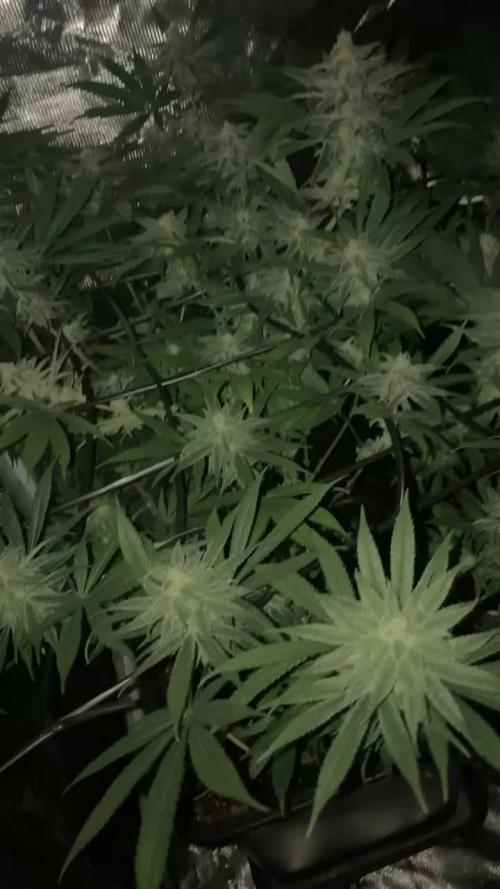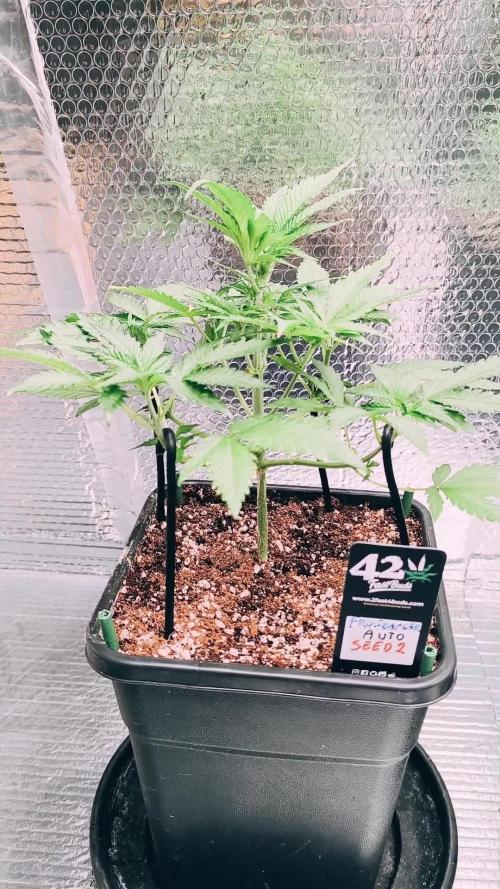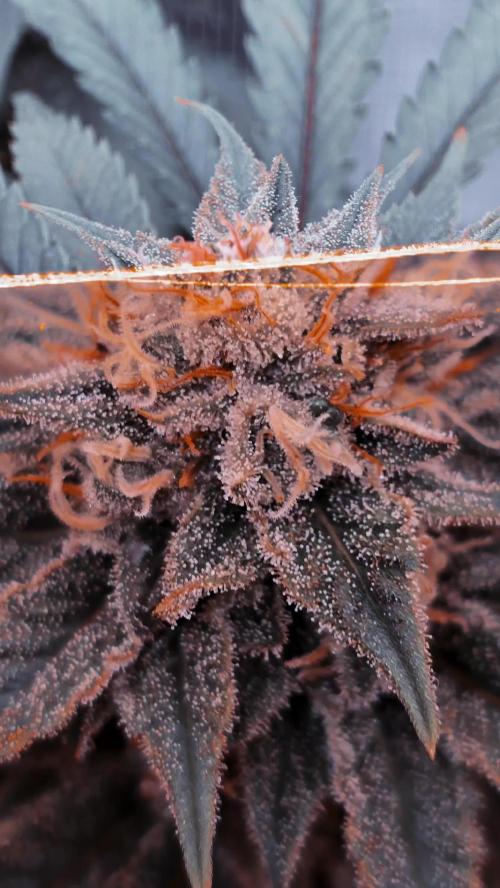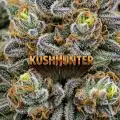The Grow Awards 2026 🏆 





































Likes
Comments
Share


@nijuana
Follow
Today is the harvest day , you can see the trichomes are ~50% amber and cloudy it's enough for this 😁
Likes
23
Share


@Kynareth
Follow
Dia 5 y las plantas ya muestran su primer par de hojas verdaderas que practicamente triplica en tamaño a los cotiledones y con un buen color verde. Pasaré a abonar conforme a la table de crecimiento y ph a 6 (algo menos realmente pero se estabilizará a 6 en las próximas horas). El ph mas y menos que uso es de boom nutrients que alguien me lo preguntó, tengo el de ghe pero como ya tengo las dosis pilladas con boom nutrients uso este, en teoría de ghe debería ser más estable pero tampoco es algo con lo que haya tenido problemas.
La ec se ha ido hasta 1,9 aplicando la dosis recomendada del fabricante, creo que el fulvic/diamond nectar sube mucho el valor. Quizás con agua destilada se puedan mantener esas dosis
Dia 10 - The plant keeps developing good. i have lowered the water dosage
Likes
21
Share


@420DeepGrow
Follow
Este sueño es posible gracias a Royal Queen Seeds, Marshydro, XpertNutrients y Trolmaster, sin ellos esto no se podria cumplir .
💐🍁 Dynamite Diesel:
Royal Queen Seeds se ha asociado con Tyson 2.0 para ofrecer la genética desarrollada por este campeón en forma de semillas.
La Dynamite Diesel recibe su nombre en honor al apodo de Mike Tyson al inicio de su carrera, Kid Dynamite. Es un cruce entre dos variedades míticas, la Sour Diesel y la Skywalker OG, que son conocidas por sus intensos sabores y sus efectos estimulantes,tiene un 22% de THC, lo que la sitúa en la categoría de peso crucero.
En interior, esta variedad crece a alturas de 100-150cm y produce hasta 550g/m² tras una fase de floración de unas 9 semanas. Al aire libre, puede alcanzar hasta 2m de altura y produce una cosecha máxima de 675g por planta.
🚀 Consigue aqui tus semillas:
https://www.royalqueenseeds.es/rqs-semillas-cannabis-tyson/664-dynamite-diesel.html
💡TS-3000 + TS-1000: se usaran dos de las lámparas de la serie TS de Marshydro, para cubrir todas las necesidades de las plantas durante el ciclo de cultivo, uso las dos lámparas en floracion para llegar a toda la carpa de 1.50 x 1.50 x 1.80.
https://marshydro.eu/products/mars-hydro-ts-3000-led-grow-light/
🏠 : Marshydro 1.50 x 1.50 x 1.80, carpa 100% estanca con ventanas laterales para llegar a todos los lugares durante el grow
https://marshydro.eu/products/diy-150x150x200cm-grow-tent-kit
🌬️💨 Marshydro 6inch + filtro carbon para evitar olores indeseables.
https://marshydro.eu/products/ifresh-smart-6inch-filter-kits/
💻 Trolmaster Tent-X TCS-1 como controlador de luz, optimiza tu cultivo con la última tecnología del mercado, desde donde puedes controlar todos los parametros.
https://www.trolmaster.com/Products/Details/TCS-1
🍣🍦🌴 Xpert Nutrients es una empresa especializada en la producción y comercialización de fertilizantes líquidos y tierras, que garantizan excelentes cosechas y un crecimiento activo para sus plantas durante todas las fases de cultivo.
Consigue aqui tus Nutrientes:
https://xpertnutrients.com/es/shop/
📆 Semana 3:
Ha sido una buena semana, ella ha dado un gran cambio en su lugar definitivo 😎.
Se le ha aplicado un tratamiento insecticida con agua + tierra de diatomeas ( 1 cucharadita por litro de agua), también se le aplica un tratamiento fungicida con una infusión de cola de caballo para evitar futuro moho.
A partir de ahora se riega manualmente con las dosis recomendadas por el fabricante.
Likes
75
Share


@Pungolian
Follow
What can i say, growing into a beastly beauty! Still dry amendments only every other watering. Went quickly from a gallon every other day to 2 1/2 gallons a day. Video is one of about 5 thunderstorms this week
Likes
10
Share


@Ananas_Comosus
Follow
Sunday, 07-08-2022
Plant looking OK. LST'd stems almost fully over pot edge and nodes on the stems developing well. Plant is still lagging behind The Church - Test Grow #6. All plants currently growing seem smaller when I compare the pics to my previous grows at the same age. Only one feed this this past week as I allowed the pots to dry out from the rain in the previous week. Supplemented feed yesterday with my Beneficial Booster. I made a mistake when preparing and put in double the amount of molasses but the plants seem to be tolerating it so far this morning.
Likes
3
Share


@Lifesgarden420
Follow
These are very awesome genetics
These budz are almost ready to chop
Likes
4
Share


@Mrgrecoa
Follow
Whats the problem? Im started with Forth Enraizador and in the week 3 im start 0.5g of plant prod in 1l of water ppm 350
Likes
58
Share


@pifflestikkz
Follow
Day 99
Day 49 Flower
09/08/24 Friday (Morning)
FLUSH- de-chlorinated tap water pH 6 with flawless finish. She's taken a full 5L with 1L run off, I shall continue to do this daily or every 1.5 days when top soil dries out.
Starting her flush this week, seeing those trichomes maturing, and pistils now forming 50-60% red.
Flush for 10-14 days depending on trichomes.
Day 100
Day 50 Flower
10/08/24 Saturday (Evening)
FLUSH- de-chlorinated tap water pH 6 with flawless finish.
Another 5L and seeing about 10-15% run off. Not quite the 1L.
Day 101
Day 51
11/08/24 Sunday (morning)
FLUSH- de-chlorinated tap water pH 6 with flawless finish. 5L run off 10%
Majority of pistils now maturing, trichomes flooded with cloudy , barely seen clear anymore, spotting a few amber's.
Day 102
Day 52 Flower
12/08/24 Monday (Morning)
FLUSH- de-chlorinated tap water pH 6 with flawless finish. 5L again with run off 10%
Day 103
Day 53 Flower
13/08/24 Tuesday (Evening)
FLUSH- de-chlorinated tap water pH 6 today again with flawless finish.
Full 5L again with 10% run off.
All fans starting to fade now, tops all bending under the weight 🤩
Euphoric sweet lemon zest smell with a gassy slap.
Video and pictures ✌️💚
Day 105
Day 55 Flower
15/08/24 Thursday (end of week)
Final FLUSH- de-chlorinated tap water pH 6 with flawless finish. Full 5L again little run.
Finally!!! The FLUSH has finished!!
She has developed beautifully 😍
All buds are solid as rocks.
She is now entering her 2 day dark period from 10am today till 10am Saturday morning ✌️💚
Processing
Likes
Comments
Share


@Greenbean15
Follow
This plant is going to be the heaviest yielding other of my purple trainwreck plants. Super excited to see what this plant will do. I was able to get the second PT clone to turn semi-purple on the bud, trich’s were better and smoke seemed to be about 2x as potent as the first grow.
I’m not sure what kind of potency this third plant will have but I’m hooping for good things. She flowered early on me instead of during 12/12(started throwing pistils) so I may have her flowering date off by a week or two. I think I stressed her into flowering by drying her out too much in veg.
Regardless, I’m excited to see what she does. So far seems to be the healthiest PT I’ve been able to grow.
Thanks for reading and happy growing! 👩🌾🏼🌱
Likes
15
Share


@BUZIMAN
Follow
Everything's fine, each one has really distinct flowers and the smell is starting to get quite strong 🤤. They drink plus minus 2 liters a day. I water them once with the pH Perfect mix, another time simply with Green Sensation(1ml/L), and once only with water at a pH of 6.5. I've been doing this cycle since last week with the Green sensation. (I think I could water them more to help them gain weight, but they seem very happy as they are, so I'll continue like this.) 😎✌️
Likes
10
Share


@bazgrow
Follow
I develop an application that measures the THC levels of cannabis
and the result comes from 3 photos of buds...
Godfather OG measured relatively well, it also measured other
strains such as Fat Banana Automatic, Gorilla Cookies Automatic,
Northern Lights Automatic,White Widow Automatic
and Gelato Auto...
See how it works in the video THC Meter...
-----------------------------------------------------
Day50 :
-----------------------------------------------------
Day air temperature: 28c
Night air temperature: 24c
Air humidity: 46%
No Watering
-----------------------------------------------------
Day51 :
-----------------------------------------------------
Day air temperature: 27c
Night air temperature: 24c
Air humidity: 39%
PH : 6.4
Watering : 0.4 l
Bio Bloom 1 ml / l
-----------------------------------------------------
Day52 :
-----------------------------------------------------
Day air temperature: 27c
Night air temperature: 23c
Air humidity: 43%
No Watering
-----------------------------------------------------
Day53 :
-----------------------------------------------------
Day air temperature: 29c
Night air temperature: 25c
Air humidity: 39%
PH : 6.4
Watering : 0.4 l
Bio Bloom 1 ml / l
-----------------------------------------------------
Day54 :
-----------------------------------------------------
Day air temperature: 30c
Night air temperature: 26c
Air humidity: 45%
PH : 6.5
Watering : 0.4 l
Bio Bloom 1 ml / l
-----------------------------------------------------
Day55 :
-----------------------------------------------------
Day air temperature: 30c
Night air temperature: 26c
Air humidity: 38%
PH : 6.4
Watering : 0.4 l
Bio Bloom 1 ml / l
-----------------------------------------------------
Day56 :
-----------------------------------------------------
Day air temperature: 28c
Night air temperature: 24c
Air humidity: 40%
Flushing Before Harvest
Processing
Likes
152
Share


@WhiteWidow
Follow
So today is the day i switch my plants to flowering lights schedule and flowering nutes, started with 1/4 the recommended dosage and will gradually up them, only boosters i left at recommended values.
Ppm is 800. Next will be 100, then 1200 and maybe 1400.
I plan to flush on days 16, 28, 35 and 42 of flowering, leave them to dry for 4-5 days so roots will oxygenize and help to stack more dense buds, and then add nutes. I plan to do the final flush for last 2 weeks with flawless finish.
You can see some before and after training photos and videos from today, defoliated some leaves and LST-ing branches, spreading them out last time so light can reach smaller branches, after all she got some more stretching to do and its why i left sensi grow with more Nitrogen.
I spent a lot of time training them now, hopefully it will pay out with massive buds :)
Stay tuned and bye bye, as always i am opened to every grower here, i will help and share advices with everyone, i love to exchange opinions in order to come to your own conclusion, people who talked to me so far already know that..
Likes
55
Share


@DogDoctorOfficial
Follow
Day 16 Since flipped to 12/12 and they are looking pretty happy i wold say, so far the Siper Farmer SF-2000 is delivering all is supposed to 😆🤟🙌
As always Aptus Holland is helping me on the food department and so much more, this is part of my secret 🤐 🤫 😆😅 they are simply the best ⭐️⭐️⭐️⭐️⭐️
Day 20 since flipped to 12/12 And for thouse of you wondering how i feed my girls, i do it in 3 times each time, and i do it by adding water to the pot trays leting them aboserve, in the video you can see what i mean 😅💚 growers love guys and hope you all having a wonderful week 💚💚💚
Seeds @seedsmanseeds Gelato OG 3x - 2 Pop out
Light spider farmer SF-2000 ( test run from seed to stone )
https://spiderfarmer.eu/collections/full-spectrum-led-grow-light/products/sf-2000-led-grow-light
https://www.amazon.es/Spider-Farmer-SF-Crecimiento-Espectro/dp/B07TYM44D6?ref_=ast_sto_dp&th=1&psc=1
https://www.amazon.com/dp/B07TVD1Y3K?ref_=ast_sto_dp
All i grow is medicine for myself, nothing to sell, don’t even ask
Do it with love for the love
💚💚💚 growers love 💚💚💚
Processing
Likes
15
Share


@Catire
Follow
Entrando en la tercera semana de flora se ven cómodas agregándole carbohidratos y big bud para que crezcan como avión siempre menos de la dosis recomendado por el fabricante, cualquier dato somos todo oídos, chauuu.
Likes
19
Share


@SmokingTiki
Follow
Despite a very good weather, the plants are stretching a lot, there is a few direct sun hours during the day and they lack light. Nevertheless, they keep growing and started to develop tiny side branches. Considering the set-up I'm really happy how it turned out so far 😎
Parameters :
-------------------------------------------
Humidity range : 35-65% depending on the sun
Temperature range : 21-30°C depending on the sun
Weather of the week : very sunny
Plants heights at the end of the week :
-------------------------------------------
Big Bud : 29.5cm
Moby Dick : 31cm
God's Glue : 24.5cm
Tequila Sunrise : 27cm
Likes
2
Share


@pHilosophy420
Follow
Day 28- Both plants growing well and getting bigger everyday.
This week both plants received small side steams trim and LST to spread the plant horizontal.
Likes
18
Share


@CanarianGrow92
Follow
Last week of flowering just finished! This plant showed some great results, the buds gets nice and fat, and slightly above average thc production, but not extreme thc like covering all the leaves, i think this is going to be a nice daily smoke without knocking you out totally!
The smell is great, just what i expected from a wedding cake! We will now harvest in some days and start to dry her 😁
Processing
Likes
2
Share


@BigHorn
Follow
Week has gone very well. Growth has exploded will be trimming back some fan leaves this coming week to help the light reach the bottom stocks that have now come in. You can see the growth explode after I transplanted the plant.
Likes
65
Share


@Roberts
Follow
Gold Sativa is doing well. She is bulking now. Has a nice frost. She got a solution change as usual and ready to go for a few days. She is in a New Level Hydro bucket, under a Spider Farmer SE5000 light. Thank you Spider Farmer, New Level Hydro, and Quebec Seeds🤜🤛🌱🌱🌱
Thank you grow diaries community for the 👇likes👇, follows, comments, and subscriptions on my YouTube channel👇. ❄️🌱🍻 Happy Growing 🌱🌱🌱
https://youtube.com/channel/UCAhN7yRzWLpcaRHhMIQ7X4g
SE5000
https://amzn.to/3qFpAML
Spider Farmer Official Website Links:
US&Worldwide: https://www.spider-farmer.com
UK: https://spiderfarmer.co.uk
CA: https://spiderfarmer.ca
EU: https://spiderfarmer.eu
AU: https://spiderfarmer.com.au
Coupon Code: saveurcash
Www.newlevelhydro.com
Www.hygrozyme.com




















